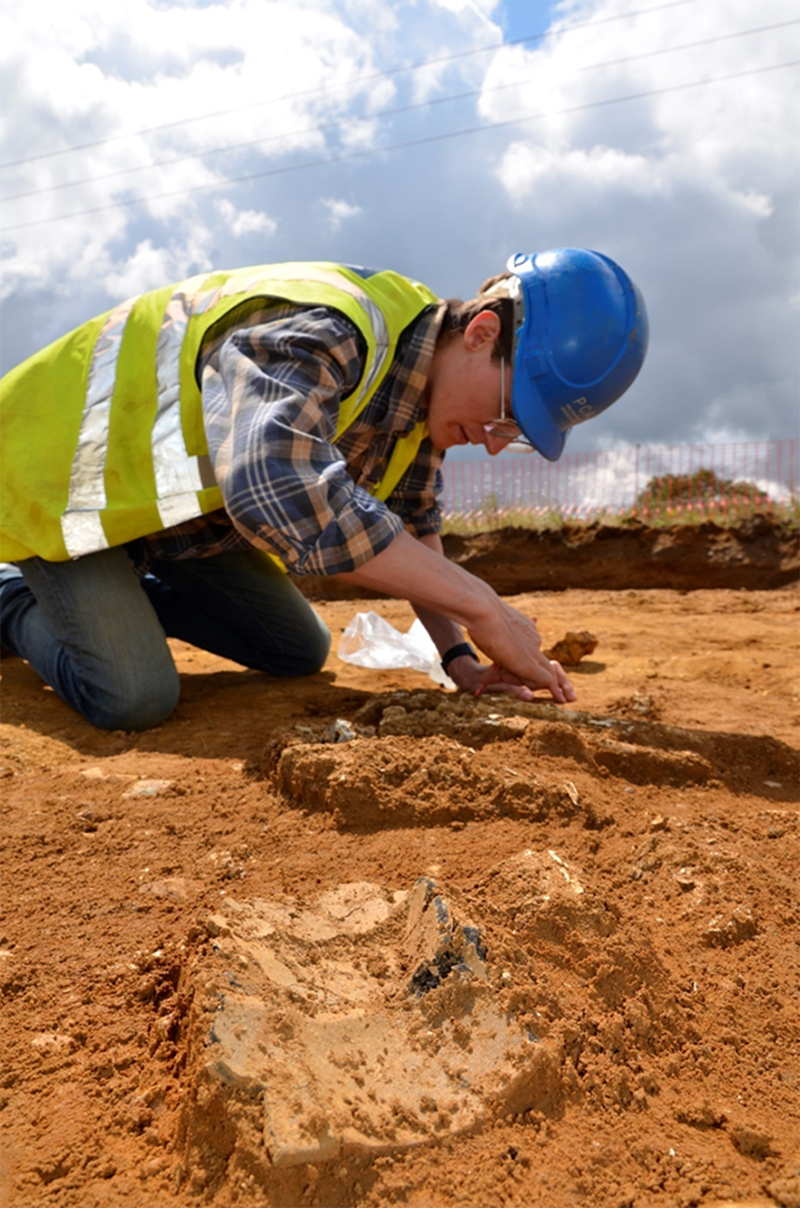Featured Image: excavating enclosure, aerial view © Pre-Construct Archaeology
A site with prehistoric remains has been excavated on the edge of Woolpit ahead of a housing development.
Excavations have revealed some interesting prehistoric archaeology at Woolpit. The earliest finds included struck flint tools, flint-working waste and ‘Mildenhall Ware’ pottery sherds, broadly dating to the Early Neolithic period. Some of these were found contained in a pit, along with pottery sherds, animal bone, charred wheat grains and hazelnut shells. Most of the flints however were recovered from natural hollows.
The most intriguing discovery was the burial of an adult man, perhaps 45 years old or more. The man had been buried in a tightly “crouched” position, with his head to the north and feet to the south. Buried with him was a decorated pottery ‘Beaker’ or drinking cup. Radiocarbon analysis dates the burial to the Early Bronze Age (2455-2204 cal. BC).
What is quite unusual, however, is that the burial was surrounded by a sub-square ditched enclosure. Unfortunately, it is difficult to firmly date the enclosure as the finds from the fill were limited; radiocarbon dating was attempted on two pieces of charcoal, which gave a very broad date from the Early Bronze Age to the late medieval period. It is possible that the enclosure may have been dug at the same time as the burial to form a mortuary enclosure, although this would make it an unusual feature in Britain for this period. Or perhaps the enclosure was dug at a slightly later date to ‘monumentalise’ the burial, which may be the reason why the burial was off-centre within the enclosure. Another interesting feature of this burial is that there was a concentration of flint nodules recorded in the overlying soil which may indicate that there was originally a flint mound or cairn over the grave.


Activity in this area continued into the Iron Age period as a small group of Middle Iron Age pits (c. 350–50 BC) containing pottery, animal bone and fired clay were also identified.
There was no other evidence of activity at the site after the Iron Age and it may be that the site had already become heathland grazing by the Roman period. The site formed part of Woolpit Heath during the medieval period, and then became farmland for perhaps several hundred years. By the 19th century, the site was part of the adjacent brickworks, and the excavations found extensive evidence for brickearth quarrying across the northern and central parts of the site.

The archaeological work was commissioned by David Wilson Homes and undertaken by Pre-Construct Archaeology, with RPS acting as archaeological consultants for the project. Suffolk County Council’s Archaeological officers monitored the project to make sure that the site was recorded and excavated to high standards.
All remains have now been fully excavated, mapped and recorded, ahead of the development which has now commenced.
The full report of the work has now been completed and will be made publicly available through the County HER in due course, and the entire archive will be deposited with Suffolk County Council’s Archaeology Service. Once this work is complete, they will be available for researchers and local museums to borrow on loan for display to the public.
The Crick Institute will also be carrying out DNA analysis of the human remains found at this site as part of their research into Ancient DNA, with the results to be included in a forthcoming publication of this site which will feature in the Proceedings of the Suffolk Institute of Archaeology and History.
Related Posts
- Viking combs put Ipswich at the heart of the early medieval world

- Iron Age, Roman and Medieval settlement above the Gipping valley

- Cruciform Brooches from Snape Anglo-Saxon Cemetery

- Exploring the Medieval Guildhall in Bury St Edmunds

- Flixton Park Quarry – The Early Anglo Saxon Cemeteries and Settlement

